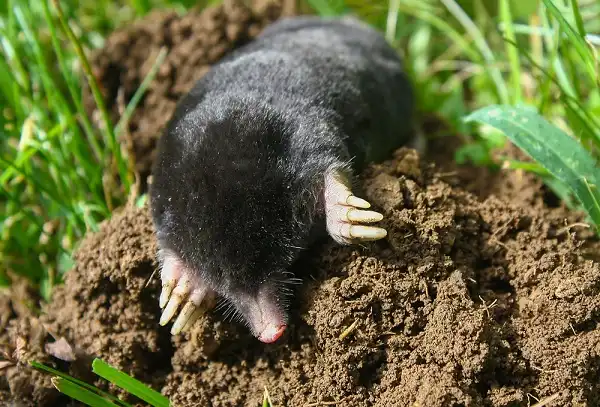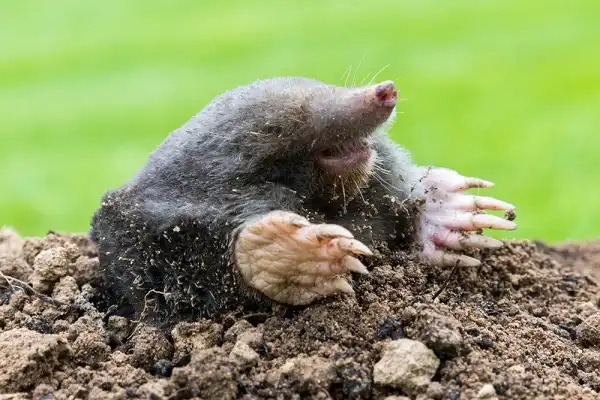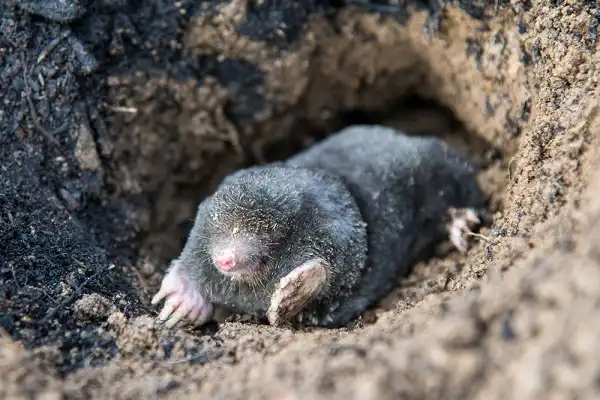Moles are small mammals that everyone is familiar with at least by sight. While many people believe they know all there is to know about moles, these cute and delicate creatures have a much more complicated lifestyle than meets the eye. From their complex diet of insects to their subterranean habitat or burrows, moles are fascinating animals with distinct adaptations for surviving in the wild–and even in our gardens! In this blog post, we’ll be exploring everything from mole anatomy to life cycle and conservation efforts aiming to protect them. Keep reading to dive deeper into the unique world of one of nature’s most curious critters: the Mole.

Mole Description
The mole, a small mammal, belongs to the Talpidae family and is found almost everywhere in the world except for Antarctica and South America. Their fur is soft and velvety, ranging in color from grey to black, and their eyes are reduced in size and covered with skin, giving them a blind appearance. However, their hearing and sense of smell are highly developed and crucial to their survival. Moles have broad front paws equipped with large claws that can be rotated to face backward, perfect for digging their complex burrow systems. Their tunnels are intricate and multi-level, consisting of chambers used for sleeping, breeding, and storing food.
Mole Habitat
Moles are incredibly adapted for life underground, which is why they thrive in a variety of habitats across the world. They are commonly found in open fields, grasslands, meadows, and forested areas, making use of the soil’s nutritious content to sustain their diet. When it comes to habitat requirements, moles prefer regions with moist soil that’s both easy and soft to dig through, providing comfortable burrow construction. They prefer soils that offer high insect populations, which are a staple of their diet. Specific mole habitats can range from grassroots to deeper soils, depending on availability and season, affecting habitat quality. Aside from their natural habitat, moles can be found in other areas such as cultivated lands, especially in agricultural areas where there is a plentiful supply of insects, earthworms, grubs, or tree roots.
However, this increases the chance for human-mole conflicts, as mole damage to crops and gardens can have economic impacts, reducing productivity and yield. Despite being found around human settlements, moles are not well adapted to urban environments, as they require particular soils and insects characteristic of natural or rural environments. Therefore, they are less likely to be found in parks, green spaces, or urban gardens. In fact, moles prefer areas with little to no human disturbance, where they can build complex tunnel systems and feed undisturbed. Mole habitats can be influenced by human activities, such as logging, farming, and suburban development, making crucial steps need to be taken towards understanding these impacts and ensuring mole habitats remain protected.
Mole Diet
Moles are omnivorous animals, meaning their diet consists of both animal and plant matter. Insects comprise the majority of their diet, particularly earthworms and grubs found in the soil. They will also consume small mammals, such as mice and voles, as well as certain plant materials, depending on availability. They have an incredibly fast metabolism, so they must constantly feed in order to sustain their energy levels. Moles can consume up to their own body weight in food each day. To meet this need for a high-energy food source, they hunt through the soil in search of nutritious prey and create elaborate tunnel systems beneath the ground to access new sources of food.

Mole Size
Moles are small, burrowing mammals that range in size from 4 to 8 inches (10 to 20 cm) long. They weigh about 2 ounces (56 g) and have a cylindrical body covered in fur. The color of their fur can range from silver-gray to black or brown, depending on the species. Moles have short legs with large front feet, which are equipped with strong claws that help them dig through the soil. They also have a pointed snout and an enlarged flattish head for pushing dirt aside as they tunnel underground. Moles possess powerful shoulder muscles that allow them to quickly move through the ground and build tunnels for protection and food storage. They create these burrows at depths of up to 6 feet (2 m). Generally, they prefer damp, loose soil with higher levels of organic matter.
Mole Lifespan
Moles, with their fascinating adaptations and dietary habits, have a relatively short lifespan compared to other mammals. On average, these small creatures live for about 2-3 years in the wild. However, some moles in captivity have been known to live up to 6 years. Their short lifespan is attributed to various factors, including high predation rates, disease, and metabolic demands. As underground dwellers, moles face significant risks from predators such as foxes, weasels, and birds of prey. Their burrowing habits also expose them to various diseases and parasites. Due to their high energy demands, moles require constant feeding, which puts a strain on their bodies. They have a fast metabolism and require up to 60% of their body weight in food each day. This requirement for a high-energy diet means that they have a shorter lifespan compared to similar-sized animals. Despite their short lifespan, moles play an essential role in soil health and ecosystem maintenance. Their burrowing habits help to aerate the soil, creating pathways for water, air, and other nutrients to penetrate deep into the ground. This process enhances the growth of plants and helps to maintain healthy soil profiles. Additionally, their tunnels act as a refuge for other small animals, providing protection from predators and extreme weather conditions.
Mole Behavior
Moles are fascinating creatures that display remarkable behavior and adaptations, making them critical contributors to the overall health and functioning of ecosystems. Their unique burrowing behavior, as previously mentioned, is one such adaptation that enables them to dig elaborate tunnels and create pathways for nutrients, air, and water to penetrate deep into the soil, promoting robust plant growth. Apart from their burrowing habits, moles display unique behavior such as their solitary nature. These small mammals are highly territorial creatures, often occupying and defending their own territories, which can range from 6 to 30 acres, depending on the species. Moles have complex social behavior, with a well-defined social order that regulates their interactions with other members of their species. They are known to create separate mating and feeding burrows and frequently communicate with each other through scent markers and vocalizations. For instance, some species use high-pitched vocalizations to communicate in the presence of predators or to warn other members of their families of potential threats.

Mole Speed
Moles are capable of moving swiftly through their underground tunnels, thanks to their unique adaptations. Their powerful front claws enable them to dig quickly and efficiently, while their fur-covered bodies reduce friction and allow them to move more freely within the burrows. Their speed depends on various factors such as the type of soil they are tunneling through, how deep they have dug their burrows, and what obstacles they may encounter along the way. Generally, moles can reach a maximum speed of up to 17 feet per minute (10 mph). They are also known to be able to make sudden turns in the mid-run without losing much momentum, allowing them to avoid predators or find food faster. Moreover, moles have a special adaptation that helps them to manage their energy efficiently. When they detect danger, they are able to quickly retreat into their tunnels and temporarily pause all activity until the threat has passed. This allows them to conserve energy and survive in the long term.
Mole Hunting
Moles are a common pest in many parts of the world, as they can cause considerable damage to lawns and gardens. Fortunately, there are numerous methods available for dealing with moles that people can use to reduce their presence in their yards or garden. The most popular method for mole hunting is trapping. There are several types of traps specifically designed for catching moles such as scissor-jaw traps, choker loop traps, and pincher traps which all work by catching the animal when it triggers the trap mechanism. When placed properly in an active mole tunnel, these traps have proven to be very effective at controlling mole populations. Another method of controlling moles is through chemical repellents. These repel are applied to the ground in an effort to discourage moles from entering the area. They contain ingredients that have a strong scent and taste which moles find unpleasant, so when they detect them, they will be deterred from coming back.
Mole Communication and Reproduction
Moles use a variety of communication techniques to communicate with one another. They have a special type of vocalization that is used for courting and mating, as well as a wide range of scents that they use to mark their territories. In addition, moles are known to perform elaborate rituals when interacting with each other. When it comes to reproduction, moles usually mate during the winter months. Females usually give birth once or twice a year and litters can range from two to seven young. Baby moles are born blind but quickly learn how to adapt to their underground environment. After about three weeks, they will start venturing out on their own and by six weeks they’ll be fully independent.

Mole Impact On Ecosystems and Human Activities
Moles play an important role in their ecosystems by digging tunnels and creating pathways for other animals to follow. These paths also help aerate soil which can improve its fertility, making it more suitable for plant growth. In addition, moles are important prey for various predators such as owls and foxes. However, moles can be a nuisance when they invade gardens or lawns and cause extensive damage to vegetation. To prevent this from happening, it is essential that people practice responsible mole management techniques such as trapping or deterring them with repellents.
Conclusion
In conclusion, moles are fascinating creatures that have evolved unique adaptations to survive in their dark and underground environment. They use their powerful claws to dig through the soil efficiently, while their fur-covered bodies reduce friction and enable them to move swiftly within the burrows. Moreover, they possess acute senses of touch and hearing which allow them to find food and evade predators. Finally, there are several methods available for controlling mole populations on your property, such as trapping and chemical repellents. By understanding more about moles and how to manage them responsibly, we can help protect these remarkable animals and ensure healthy ecosystems for future generations.
Frequently Asked Question


